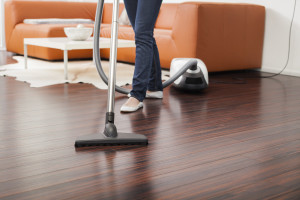 You invested thousands into your new hardwood floors and now it is time to clean them. Or perhaps you purchased an older home with existing hardwood floors. Now you are wondering what is the best way to clean them. In fact, it is very important that you use the right materials on your floors. You want to ensure a long life for your floors as well as continuing to make them look great. So before you begin cleaning hardwood floors, stop for a second. Look at the wood finish on your floors to assess what kind it is. Depending on the finish you may need to choose a different style of cleaner to clean them. The following are the general types of hardwood floors:
You invested thousands into your new hardwood floors and now it is time to clean them. Or perhaps you purchased an older home with existing hardwood floors. Now you are wondering what is the best way to clean them. In fact, it is very important that you use the right materials on your floors. You want to ensure a long life for your floors as well as continuing to make them look great. So before you begin cleaning hardwood floors, stop for a second. Look at the wood finish on your floors to assess what kind it is. Depending on the finish you may need to choose a different style of cleaner to clean them. The following are the general types of hardwood floors:
- Surface-sealed floors
- Penetrating-seal-treated and oil-treated floors
- Lacquered, varnished, shellacked and
- Untreated floors
Cleaning Hardwood floors
Surface-sealed floors :
this is the most common type of floor covering for hardwood floors. These floors are sealed with urethane, polyurethane, or polycyclic materials and are stain and water damage resistant. They are the easiest to care for since the floor is sealed. All you need to do is sweep the floor to remove all grit and dust etc and then mop the floor. Be careful to avoid leaving excess amounts of water on any floor including this one even though it is water-resistant.
Penetrating-seal-treated and oil-treated floors:
Some floors have a penetrating oil finish to them to bring out the grain in the wood. This penetrating oil really does not provide any protection. All it does is penetrate the wood and enhance the grain of the wood to provide an aesthetically pleasing look to it. Many people will protect this type of floor with liquid or paste wax.
Lacquered, varnished, shellacked floors:
Varnishes and shellacked finishes are really surface finishes, however, they are unable to protect the floor from water and other liquids in the same manner as urethane, etc. As a result, they must be treated with care and in the same way, you would treat a floor that has been treated with penetrating oil floors.
Untreated floors:
Floors that are still bare wood have no protection in them at all and will absorb water and other liquids very quickly. It is important to avoid spilling any water on these floors let alone cleaning them with soap and water.
Many people find it difficult to tell what kind of floor they have unless they purchased it themselves. Older homes that people move into may have hardwood floors but unless the original owners are available to tell you what type of floor it is, you will have to discover the type of floor finish yourself. One way to tell what type of hardwood floor you have is to rub your finger across the floor. If no surface smudge appears then it is surface sealed. If there is a smudge, then it has been treated with an oil finish or shellac type of finish. Of course, floors that are just bare wood will also not show a smudge since there is no finish on these floors at all.
Heavily worn floors also have to be given careful consideration. Floor areas in high traffic paths may be worn to the extent that the bare wood is showing through the surface seal. Treat these areas in the same manner as you wood with a bare floor with no finish at all.
Next Post
Our next post will discuss specifics about how to clean each type of floor mentioned in this post. The title will be “Cleaning Surface Sealed and non-Surface Sealed Floors”. If you found this post helpful or would like to contribute a comment, please do so. any comments that are constructive and helpful to our readers will be posted. We will even approve your link if it is a good comment that our readers will find helpful.
October 10th, 2012 on 4:01 pm
we are considering getting hardwood floors for our home. we have rugs now and this web site has helped a lot in terms of selecting hardwood floor and then looking after it once we have them installed.